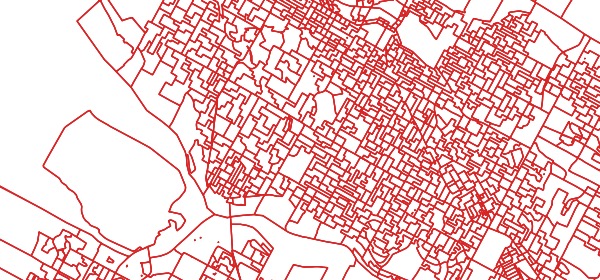Parallel PostGIS and PgSQL 12
27 May 2019For the last couple years I have been testing out the ever-improving support for parallel query processing in PostgreSQL, particularly in conjunction with the PostGIS spatial extension. Spatial queries tend to be CPU-bound, so applying parallel processing is frequently a big win for us.

Initially, the results were pretty bad.
- With PostgreSQL 10, it was possible to force some parallel queries by jimmying with global cost parameters, but nothing would execute in parallel out of the box.
- With PostgreSQL 11, we got support for parallel aggregates, and those tended to parallelize in PostGIS right out of the box. However, parallel scans still required some manual alterations to PostGIS function costs, and parallel joins were basically impossible to force no matter what knobs you turned.
With PostgreSQL 12 and PostGIS 3, all that has changed. All standard query types now readily parallelize using our default costings. That means parallel execution of:
- Parallel sequence scans,
- Parallel aggregates, and
- Parallel joins!!
TL;DR:
PostgreSQL 12 and PostGIS 3 have finally cracked the parallel spatial query execution problem, and all major queries execute in parallel without extraordinary interventions.
What Changed
With PostgreSQL 11, most parallelization worked, but only at much higher function costs than we could apply to PostGIS functions. With higher PostGIS function costs, other parts of PostGIS stopped working, so we were stuck in a Catch-22: improve costing and break common queries, or leave things working with non-parallel behaviour.
For PostgreSQL 12, the core team (in particular Tom Lane) provided us with a sophisticated new way to add spatial index functionality to our key functions. With that improvement in place, we were able to globally increase our function costs without breaking existing queries. That in turn has signalled the parallel query planning algorithms in PostgreSQL to parallelize spatial queries more aggressively.
Setup
In order to run these tests yourself, you will need:
- PostgreSQL 12
- PostGIS 3.0
You’ll also need a multi-core computer to see actual performance changes. I used a 4-core desktop for my tests, so I could expect 4x improvements at best.
The setup instructions show where to download the Canadian polling division data used for the testing:
pda table of ~70K polygonsptsa table of ~70K pointspts_10a table of ~700K pointspts_100a table of ~7M points

We will work with the default configuration parameters and just mess with the max_parallel_workers_per_gather at run-time to turn parallelism on and off for comparison purposes.
When max_parallel_workers_per_gather is set to 0, parallel plans are not an option.
max_parallel_workers_per_gathersets the maximum number of workers that can be started by a single Gather or Gather Merge node. Setting this value to 0 disables parallel query execution. Default 2.
Before running tests, make sure you have a handle on what your parameters are set to: I frequently found I accidentally tested with max_parallel_workers set to 1, which will result in two processes working: the leader process (which does real work when it is not coordinating) and one worker.
show max_worker_processes;
show max_parallel_workers;
show max_parallel_workers_per_gather;Aggregates
Behaviour for aggregate queries is still good, as seen in PostgreSQL 11 last year.
SET max_parallel_workers = 8;
SET max_parallel_workers_per_gather = 4;
EXPLAIN ANALYZE
SELECT Sum(ST_Area(geom))
FROM pd;Boom! We get a 3-worker parallel plan and execution about 3x faster than the sequential plan.
Scans
The simplest spatial parallel scan adds a spatial function to the target list or filter clause.
SET max_parallel_workers = 8;
SET max_parallel_workers_per_gather = 4;
EXPLAIN ANALYZE
SELECT ST_Area(geom)
FROM pd; Boom! We get a 3-worker parallel plan and execution about 3x faster than the sequential plan. This query did not work out-of-the-box with PostgreSQL 11.
Gather
(cost=1000.00..27361.20 rows=69534 width=8)
Workers Planned: 3
-> Parallel Seq Scan on pd
(cost=0.00..19407.80 rows=22430 width=8)
Joins
Starting with a simple join of all the polygons to the 100 points-per-polygon table, we get:
SET max_parallel_workers_per_gather = 4;
EXPLAIN
SELECT *
FROM pd
JOIN pts_100 pts
ON ST_Intersects(pd.geom, pts.geom);
Right out of the box, we get a parallel plan! No amount of begging and pleading would get a parallel plan in PostgreSQL 11
Gather
(cost=1000.28..837378459.28 rows=5322553884 width=2579)
Workers Planned: 4
-> Nested Loop
(cost=0.28..305122070.88 rows=1330638471 width=2579)
-> Parallel Seq Scan on pts_100 pts
(cost=0.00..75328.50 rows=1738350 width=40)
-> Index Scan using pd_geom_idx on pd
(cost=0.28..175.41 rows=7 width=2539)
Index Cond: (geom && pts.geom)
Filter: st_intersects(geom, pts.geom)
The only quirk in this plan is that the nested loop join is being driven by the pts_100 table, which has 10 times the number of records as the pd table.
The plan for a query against the pt_10 table also returns a parallel plan, but with pd as the driving table.
EXPLAIN
SELECT *
FROM pd
JOIN pts_10 pts
ON ST_Intersects(pd.geom, pts.geom);Right out of the box, we still get a parallel plan! No amount of begging and pleading would get a parallel plan in PostgreSQL 11
Gather
(cost=1000.28..85251180.90 rows=459202963 width=2579)
Workers Planned: 3
-> Nested Loop
(cost=0.29..39329884.60 rows=148129988 width=2579)
-> Parallel Seq Scan on pd
(cost=0.00..13800.30 rows=22430 width=2539)
-> Index Scan using pts_10_gix on pts_10 pts
(cost=0.29..1752.13 rows=70 width=40)
Index Cond: (geom && pd.geom)
Filter: st_intersects(pd.geom, geom)
Conclusions
- With PostgreSQL 12 and PostGIS 3, most spatial queries that can take advantage of parallel processing should do so automatically.
- !!!!!!!!!!!



